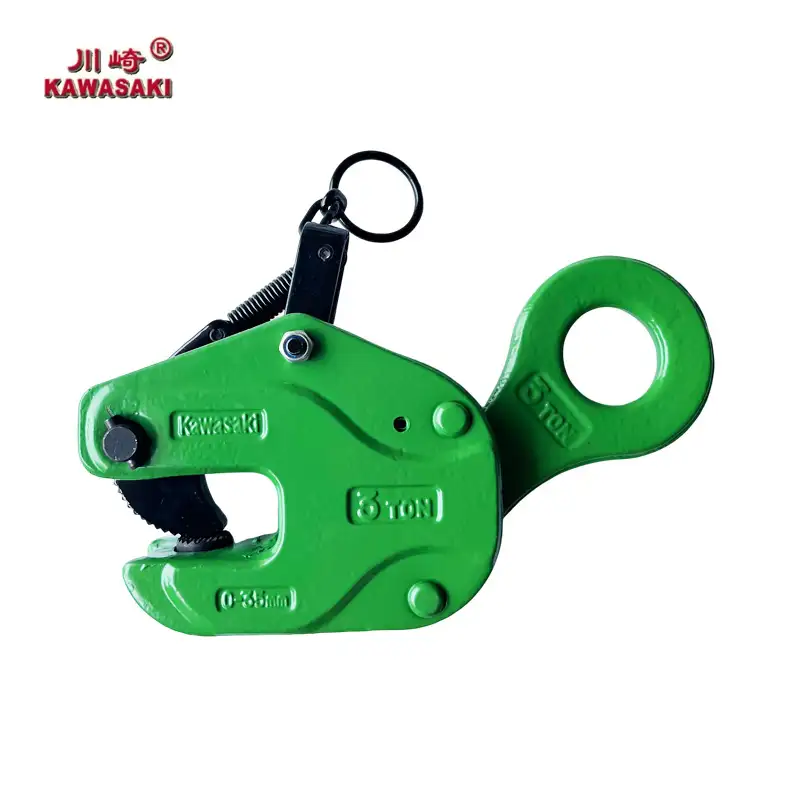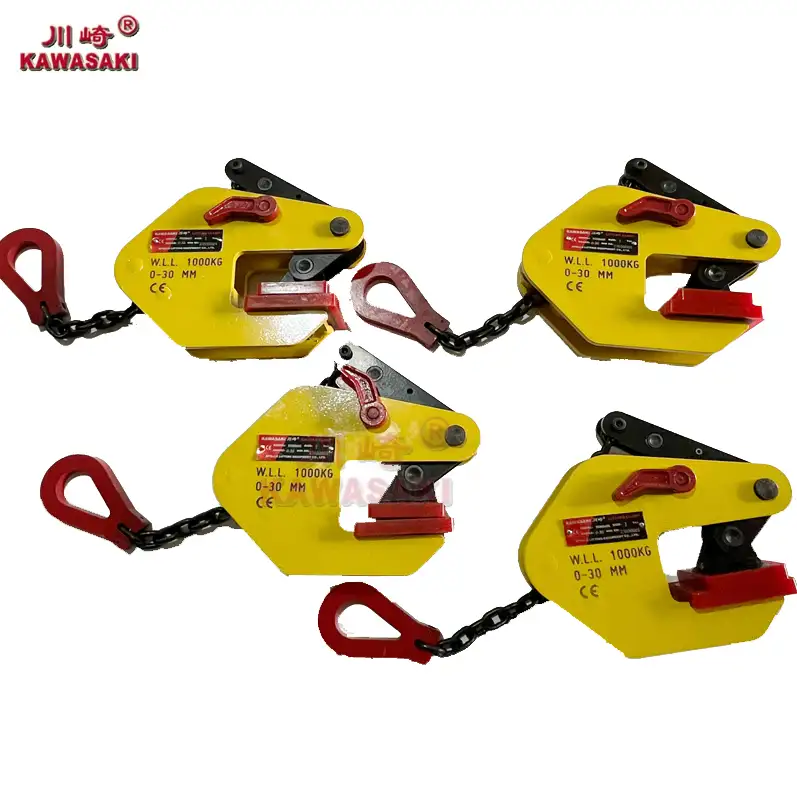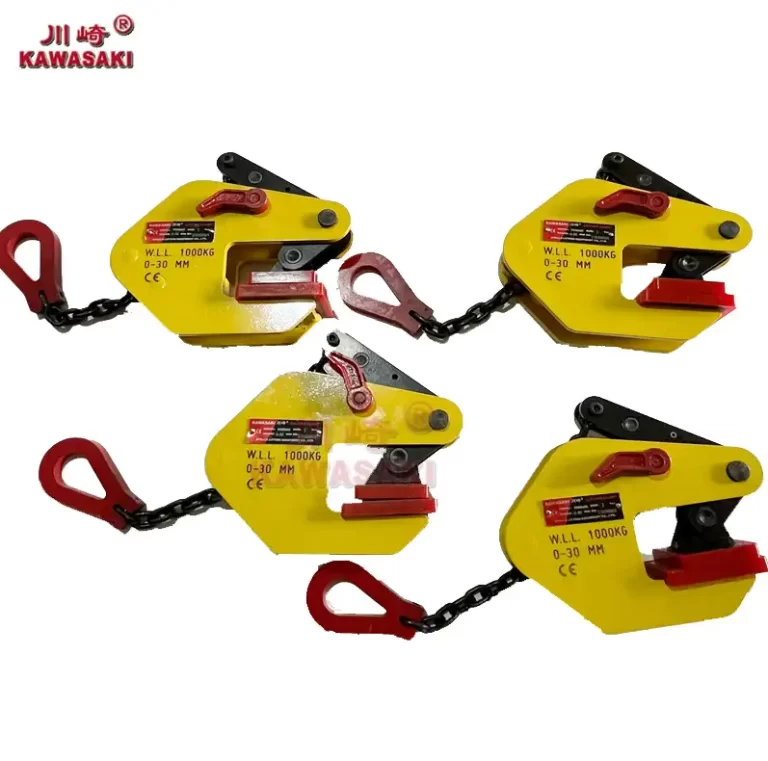At construction sites, factories, and shipyards where heavy steel plates are frequently handled, steel plate clamps provide a safe and efficient solution for lifting and securing these materials. However, operational errors can occur, potentially causing plate drops, clamp damage, or even injuries. This article examines common operational pitfalls and offers practical solutions to ensure workplace safety.
Why Are You Choosing the Wrong Plate Clamp for the Job
Picking the right clamp sets the stage for safe work. Get it wrong, and things go south fast. Workers often grab whatever’s handy without thinking about the load or setup. Here’s how to spot and skip those pitfalls.
Incorrect Load Capacity Selection
A clamp that’s too weak for the job might give way mid-lift. Imagine hauling a heavy steel sheet only for it to crash down. Apollo‘s Kawasaki Vertical Lifting Clamp E handles up to 5 tons easy. Built with alloy steel and a 3.5 times safety buffer, it keeps things steady. Match the clamp’s rating to your plate’s weight every time. No guesses.
Mismatched Clamp Type for Material
Vertical clamps aren’t made for side pulls. They slip on horizontal jobs, scratching plates or worse. Switch to something like the Kawasaki Horizontal Lifting Clamp KNMK for flat lifts. Its design locks in tight without budging. Apollo tweaks these for different metals too—think galvanized chains for rusty spots.
Ignoring Customization Options
Off-the-shelf clamps work okay, but custom ones shine in odd jobs. Dust or rain can wreck standard gear. Apollo lets you tweak the Kawasaki Vertical Lifting Clamp QC with rain-proofing or two-speed controls. Minimum order’s just 50 units. Tailor it to your site, and watch downtime drop.
Are You Inspecting Plate Clamps Properly Before Use
Checks before lifting sound basic, but folks rush through them. A quick look-over catches cracks or loose parts that could spell trouble. Skipping this step? Big risk. Let’s break down what to watch for.
Neglecting Pre-Use Visual Checks
Dirt hides wear on hooks or jaws. Miss that, and the clamp fails when it counts. The Kawasaki Vertical Lifting Clamp E from Apollo uses tough alloy forging, but even strong stuff needs eyes on it daily. Wipe it down, check for bends. Simple habit saves headaches.
Overlooking Manufacturer Guidelines
Manuals gather dust, right? Wrong move. They spell out limits like max angles or chain lengths. Apollo packs clear instructions with every Kawasaki Horizontal Lifting Clamp KNMK. Follow them, and the high-temp quenched gears stay in top shape. Ignore, and you’re asking for slips.
Skipping Load Testing
Testing under weight spots weak spots early. No test means hidden flaws pop up during real work. Apollo runs 200% overload tests on the Kawasaki Vertical Lifting Clamp QC before shipping. Do your own light test on-site. It’s quick and confirms the clamp’s ready.
How Can You Ensure Proper Installation of Plate Clamps
Setting up right keeps the grip firm. Mess this up, and plates shift or fall. It’s not rocket science, but details matter. Focus on position and tightness to avoid headaches.
Incorrect Clamp Positioning
Slap it on crooked, and the clamp bites uneven. Leads to wobbles or drops. The Kawasaki Vertical Lifting Clamp E grabs vertical plates dead center with its V-design. Line it up square every time.

Inadequate Tightening
A loose clamp is useless. It slides off under strain. Tighten the Kawasaki Horizontal Lifting Clamp KNMK’s wear-resistant hook fully—its baking process keeps it grippy. Turn that handle till it’s snug. No half-measures here.
Ignoring Plate Surface Conditions
Oily or rough plates make clamps slip. Clean ’em first. Apollo offers surface tweaks like electroplating on the Kawasaki Vertical Lifting Clamp QC. Handles slick steel no problem. Prep the plate, and the clamp holds true.
Are You Overloading Your Plate Clamps
Pushing past limits wrecks clamps and risks lives. Overloads happen when teams underestimate weights or rush. Stay under ratings, and gear lasts longer. Here’s the lowdown.
Exceeding Rated Capacity
Pile on too much, and clamps bend or break. Stick to specs. The Kawasaki Vertical Lifting Clamp E takes 5 tons max, with that extra safety margin. Weigh your load first. Apollo builds in forgiveness, but don’t test it.
Ignoring Dynamic Load Factors
Jerks or swings amp up the force. What feels light static gets heavy in motion. The Kawasaki Horizontal Lifting Clamp KNMK’s solid build absorbs shocks. Move slow and steady. Cuts down on surprises.
Neglecting Multi-Clamp Coordination
Two clamps? Balance the load or one takes it all. Uneven pull twists things. Apollo’s Kawasaki Vertical Lifting Clamp QC works great in pairs—custom chains help sync them. Spread the weight even, check angles.
Why Is Operator Training Critical for Plate Clamp Safety
Training turns rookies into pros. Without it, mistakes multiply. Sites with spotty skills see more mishaps. Drill the basics, and everyone stays sharp.
Lack of Proper Training
New hands fumble clamps, leading to drops. Hands-on practice fixes that. Apollo’s Kawasaki Vertical Lifting Clamp E is straightforward, but demos help. Run sessions on gripping and releasing. Builds confidence fast.
Ignoring Safety Protocols
Shortcuts like skipping locks invite trouble. Protocols exist for a reason. The Kawasaki Horizontal Lifting Clamp KNMK has built-in brakes—use ’em. Apollo includes video guides for safe habits. Stick to the rules.
Inconsistent Skill Levels
Mixed teams mean uneven work. Level up with refreshers. Apollo’s manuals for the Kawasaki Vertical Lifting Clamp QC standardize steps. Group training keeps everyone on the same page. No weak links.
How Do You Maintain Plate Clamps for Longevity
Upkeep keeps clamps going strong. Neglect them, and they quit early. Regular care pays off in fewer replacements. Tackle it step by step.
Skipping Regular Maintenance
Dust and grime gum up parts. Clean after use. The Kawasaki Vertical Lifting Clamp E’s alloy stays tough with oiling. Wipe hooks, lube gears. Apollo’s one-year warranty backs it, but maintenance stretches that.
Improper Storage Practices
Toss ’em in the rain? Rust sets in quick. Store dry and covered. Apollo’s galvanized Kawasaki Vertical Lifting Clamp QC fights corrosion. Hang ’em up, away from elements. Lasts way longer.
Delaying Repairs
Cracks grow if ignored. Fix small issues now. Apollo offers parts for the Kawasaki Horizontal Lifting Clamp KNMK. Quick swaps keep downtime low. Don’t wait for breaks.
Are You Leveraging Apollo’s Customization for Optimal Performance
Custom tweaks make clamps fit like gloves. Standard ones fall short in weird setups. Apollo’s options turn good tools into great ones. Explore them.
Overlooking Surface Treatment Options
Harsh spots eat unprotected metal. Add coatings. The Kawasaki Vertical Lifting Clamp QC takes nickel-plating for salt air. Apollo customizes easy—pick spray paint or oxidation. Gear holds up better.
Ignoring Voltage Customization
Wrong power fries motors. Match your site’s setup. Apollo tweaks the Kawasaki Vertical Lifting Clamp E for 110V to 575V, single or three-phase. Global jobs? No sweat. Keeps operations humming.
Missing Branding Opportunities
Plain clamps blend in. Add your logo. Apollo’s OEM for the Kawasaki Horizontal Lifting Clamp KNMK includes colors and marks. Builds brand on-site. Minimum 50 units—worth it for pros.
FAQs
Q1: What makes Apollo’s plate clamps stand out from competitors?
A: Apollo focuses on custom features like explosion-proofing and varied surface treatments, backed by ISO and CE certs. Their Kawasaki line offers sturdy alloy builds at fair prices, with sales agents across Asia.
Q2: How often should plate clamps be inspected?
A: Daily visual checks before use, plus full tests monthly or after heavy jobs. Follow Apollo’s guides for their models to catch wear early.
Q3: Can Apollo customize clamps for small orders?
A: Yes, minimums start at 50 units for most electric types. They handle OEM branding, voltage tweaks, and more to fit specific needs.


